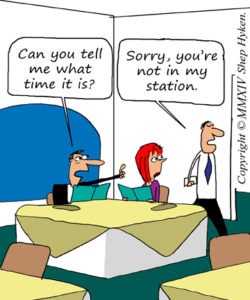 It’s not my department
It’s not my department
I hate the handoff. This is where the customer service representative I’m talking to transfers me to someone else to resolve my issue. It can happen on the phone or in person. Sometimes I hear, “It’s not my department.” (I hate that one!) Or, “You should have asked to speak to someone in…” Well, you can name the department. I think you get the idea.
On the phone, this is the way it usually plays out. First I call the company. Then I listen to the voice prompts that will connect me with the correct department. If I’m lucky I won’t have to wait. However there is usually a short wait. Some companies have gotten better at managing the customer’s wait times. During the wait, I’ll typically hear a message like, “Your call is very important to us. Please hold for the next available customer care representative.” Well if it was so important, why do they make me wait? But, I digress.
Once I get the agent on the phone, the agent will typically ask me necessary questions to prove I am who I say I am. Those questions could include an account number, address, last four digits of my social security number, and more. Then the phone call really begins. That’s when I hope that the person I’m talking to can help me, fix what needs to be fixed, and give me a great customer service experience. But, sometimes that is not the case. I have to be transferred to someone else in another department. Guess what happens? The process starts all over again. Sometimes there is a wait, and almost always I have to go through the same question and answer session.
For the typical person, this process is frustrating, mostly because of the time wasted.
A good handoff is almost artistic. Done well, the customer appreciates the first person they talked to, even if he or she didn’t resolve the issue, because of the positive way the call is handled.
I was working at a call support center. A customer was transferred to the agent I was working with. I expected to be talking to the customer. Instead, I heard another agent say, “Hello. I have Mrs. Smith (not her real name) on the phone. She is having trouble with her login and password. Would you be able to help?”
Of course, my agent said, “Yes.” And the support call began. It was a warm handoff. Instead of being frustrated, the customer was very appreciative of the first agent, and even more so for the agent who helped resolve the issue.
It doesn’t matter if it is a customer support center or in person – and it can be any type of business – the customer hates a bad handoff. So, here are a few things to consider:
- Make the handoff warm. Sometimes it takes an introduction.
- Do your best to prevent the customer from having to tell their story (or give their identifying information) more than once – make that part of your introduction to the next agent.
- Make sure the customer only has to experience the handoff one time. For example, if it is on the phone, transfer only once. In person, get the customer to the right person the first time.
- Consider giving the customer your contact information in case they are disconnected, their issue hasn’t been resolved, or have other problems in the future.



